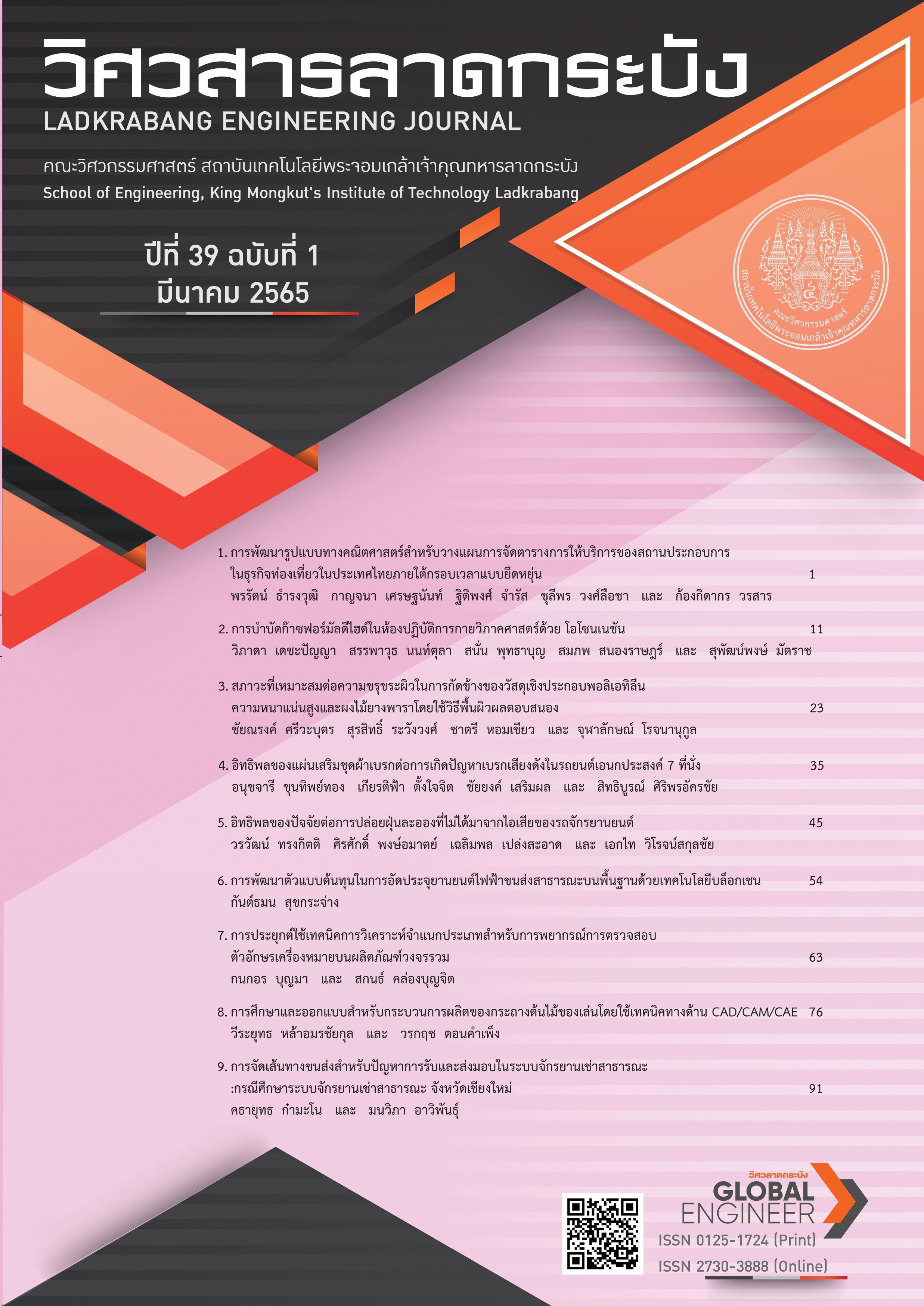Influence of Brake pad shim on the Brake Noise for Sports Utility Vehicle (SUV) 7 Seats
Keywords:
Complex eigenvalue analysis (CEA), Finite Element, Brake pads shim, Brake high frequencyAbstract
The purpose of this research is studying influence of Brake pad shim to avoid brake high frequency noise in with range 4–16 kHz, is called “High Frequency Brake Squeal Noise” for Sports Utility Vehicle (SUV) 7 seats. The method of this studying including demonstrate on the vehicle testing and finite element analysis. The finite models existing such as Brake disc vane, Brake pads lining, Brake pads plate and Brake pad shims are established by SimXpert 2020 software. To understand brake squeal noise mechanism, the Complex Eigenvalue Analysis (CEA) technique is used for stability analysis of brake system that under influence of friction coefficient. The result showed, experimental testing on vehicle data and finite element analysis by CEA are corresponding, brake squeal noise is generated at frequency within range is 14.8–16.5 kHz on the friction coefficient 0.5 and pressure 5 MPa. To avoid brake squeal noise and unstable mode, there are various methods and approaches to correct such as brake component modification, structural damping increasing, material properties improvement etc. These methods could shift and improve resonance frequencies and mode vibrations for brake disc and brake pads where are the factors of unstable modes of brake squeal noise by friction coefficient. A simple of Brake pad shim metal is modified and studied on this research, the dimension of shape is 38.7 mm × 130.74 mm × 1 mm for the wide, length and thickness, respectively and the total area is equal 7,898.18 mm2. The surface of shim is drilled to be curve slot and one circle on the middle of component and assumed the material properties is stainless steel. Then, Brake pad shims are bonded on the brake pads to increase structural damping and simulated on the similar condition by CEA, the result showed this modification could avoid high frequency brake squeal noise is efficiency.
References
A. Khuntiptong and C. Chantalakhana, “On the Study of Disc Brake Vane Configuration Effected to Brake Squeal Noise,” in The 7th TSME International Conference on Mechanical Engineering, Chiang Mai, Thailand, Dec. 13–16, 2016, AMM001.
X. Wang, S. John and H. Ren, “A Study of Squeal Noise in Vehicle Brake System,” in Proc. of the ASME 2011 International Mechanical Engineering Congress & Exposition, Denver, Colorado, USA, Nov. 11–17, 2011, doi: 10.1115/IMECE2011-62084.
A. Khuntiptong “Study and Development of Disc Brake for Noise and Vibration Reduction,” Ph.D. dissertation, ME Dept., KMUTNB Univ., Bangkok, Thailand, 2016.
S. Khuntiptong and et al, “On the Study of In-Plane and Out-Plane Rotor Vibration Modes Effected to Brake Squeal Noise,” in 27th Conference of the Mechanical Engineering Network of Thailand., Pattaya, Chonburi, Thailand, 2013, pp. 1–9.
A. Nobari, H. Ouyang and P. Bannister, “Statistics of complex eigenvalues in friction-induced vibration,” Journal of Sound and Vibration, vol. 338, pp. 169–183, 2015, doi. 10.1016/j.jsv.2014.10.017.
A. Khuntiptong and C. Chantalakhana, “On the Study of Disc Cheek Thickness as a Design Parameter for Reducing of Brake Squeal Noise,” in TSME-ICOME, Cha-am, Phetchaburi, Thailand, 2015, pp. 1–6.
F. Chen, C.A. Tan, and R.L. Ouaglia, “Disc Brake Squeal: Mechanical, Analysis, Evaluation and Reduction/Prevention.,” Warrendale, Pa.:SAE International, 2006, pp. 1–401.
N. M. Ghazaly, M. EI-Sgarkawy and I. Ahmed, “A Review of Automotive Brake Squeal Mechanisams,” Journal of Mechanical Design and Vibration, vol. 1, no. 1, pp. 5–9, 2014, doi: 10.12691/jmdv-1-1-2.
V. Kumar, S. V. Chaitanya and S. B. Phadke, “Automotive Brake Disc Design to Suppress High Frequency Brake Squal Noise,” International Journal of Engineering Research & Technology, vol. 3, no. 1, 2014.
K. Suwantaroj and S. Lakkam, “Brake Noise Reduction Using Brake Pad with Damping Layer Technique,” Faculty of Engineering, Rajamangala University of Technology Phra Nakhon, Bangkok, Thailand, final rep., 2017.
K. Shang, X. Liu and E. Moureh-Ledig, “Squeal simulation and analysis of brake system with pressure and speed dependent friction model and exerting process of pressure,” Journal of Vibrroengineering, vol. 19, no. 3, pp. 2090–2105, 2017, doi: 10.21595/jve.2016.17351.
A. Rakim ABU Bakar, M. Kameil Abdul Hamid and K. Bin Zakaria, “Reduction of Disc Brake Squeal Noise Using Constrained Layer Dampers,” Jurnal Teknologi (Science & Engineering), vol. 79, no. 7-4, pp. 83–87, 2017, doi: 10.11113/jt. v79.12269.
G. Pan, Y. Li and L. Chen, “Impact Analysis and Optimization of Material Parameters of Insulator on Brake Squeal,” IEEE Access, vol. 7, pp. 15861–15867, 2019, doi: 10.1109/ACCESS.2019.2894781.
D. Schmid and et al., “Parameter Identification of Brake Pad Shims for Complex Eigenvalue Analysis,” Proceeding in Applied Mathematics, 2019.
J. Glisovic and D. M. Miloradovic, “Eliminating Brake Noise Problem,” Mobility & Vehicle Mechanics, vol. 36, no. 3, pp. 35–51, 2010.
Trelleborg Sealing Solutions Kalmar AB “Shims / Insulators.” rubore.com. https://www.rubore.com/en/products-applications/shims-insulators (accessed Mar. 10, 2022).
Downloads
Published
How to Cite
Issue
Section
License
Copyright (c) 2022 Faculty of Engineering, King Mongkut’s Institute of Technology Ladkrabang

This work is licensed under a Creative Commons Attribution-NonCommercial-NoDerivatives 4.0 International License.
The published articles are copyrighted by the School of Engineering, King Mongkut's Institute of Technology Ladkrabang.
The statements contained in each article in this academic journal are the personal opinions of each author and are not related to King Mongkut's Institute of Technology Ladkrabang and other faculty members in the institute.
Responsibility for all elements of each article belongs to each author; If there are any mistakes, each author is solely responsible for his own articles.






